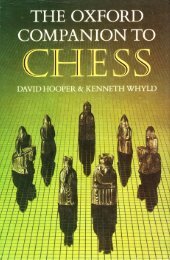Create successful ePaper yourself
Turn your PDF publications into a flip-book with our unique Google optimized e-Paper software.
352 'IIiREE HANDED CHESS<br />
Whne.s pie*son the lo*esr rier from Aal ro Ahl,<br />
Black\onlhe<strong>to</strong>p tier Ha8<strong>to</strong> Hh8, andthc paBns<br />
placcd above and belos theNhite and black pieces<br />
respectively. Maack, wbo believed $e onginal<br />
r.rm.r<strong>chess</strong>wasrhree dimensional d.scribedhis<br />
gane lbr the irst ti6e in thc Fra,kflnt Z.itun|,<br />
1907, and subscqrc.rly in two magazines lounded<br />
for the pu.pose and in several books.<br />
A more mana8eable lom was de$ribed <strong>by</strong><br />
DAwsoN in 1926. Five 5 x 5 boards arc supcrimposed<br />
(125 celh). <strong>The</strong> rook is moved throngh cell<br />
faces, the bishop throngh cell edges, lhe unicorn<br />
(U) thrcugh cell cornersi a lourth line piece, the<br />
queen, conbines lhe poves of tnc othcr lhree.<br />
<strong>The</strong> king is noved like thc queen bu<strong>to</strong>nlyin single<br />
sreps, so that aking onBb2sould have a 6eld ot26<br />
cells. Tl,e kniEht is moved nomally in all Planes.<br />
whitc\ ten pawns, innialy aligned lrom Aa2 <strong>to</strong><br />
Ae2 and Ba2 <strong>to</strong>Be2, are moved insinglc steps only<br />
<strong>to</strong>*ards theirpromotjon rank EaJ <strong>to</strong> E€5. making<br />
non caplurine movcs like a rook and capiuring<br />
moveslikeabishop. Black\pawnsinnialyaligned<br />
fron Ea4 lo Ee4 and Da4 <strong>to</strong> D€,1 are moved<br />
similarly lowards their promotion rank Aal lo<br />
Ael <strong>The</strong> inilial placing ol lbe pieces is as folloNs:<br />
White R, N. K,N, R irom Aal <strong>to</strong> Acl andB, U,O,<br />
B, U lros Bal <strong>to</strong> Bcli Black R, N, K, N. R lrom<br />
Eas <strong>to</strong> Ees and U, B, Q, U, B from Da5 roDe5.<br />
In 1945 the Englih player Charles Bealty<br />
introduced <strong>to</strong>tal ch c$' rat her like Maack'svenion<br />
but usins lour 8 x 8 boards (256 celh) <strong>The</strong>re have<br />
beenotheraltempts NonehascaughtlheiBagina<br />
tion of the <strong>chess</strong> playing public, but thc version<br />
outlined <strong>by</strong> Dawson is used <strong>by</strong>composes ofrtunY<br />
pRoBr-EMsi conposeB have also used. conceplual<br />
four-dinensional version<br />
THREE-EANDED CHESS, an lnorthodox game<br />
lor three playeB. Of less importance his<strong>to</strong>rically<br />
than four-handed<strong>chess</strong>thelhree-handed gme has<br />
neler been popular <strong>The</strong> earliesr special board,<br />
dating from 172, corsisled of the nomal 64<br />
squa.es vith 24 squares (8x3) added<strong>to</strong>threesides.<br />
Mare could notbe given <strong>by</strong> two players conbided<br />
and bolh advcrsaries had <strong>to</strong> be ma1ed. Ttis shape<br />
oI board does not give each player equal opportnnities.<br />
To obriate tnis delecl a symmetncal board<br />
was designed in 1837 consisnng oI rhree wedBe<br />
shapcd piec.s loincd <strong>to</strong>gether. Each wedge had<br />
4x8 o.dinary squa.es and then. along one ofthe<br />
lone sides, sir rapenng squares and beyond them<br />
tso more tapennS squares, the whole board<br />
conp.ising 120 sqnares. (In efiect the 24tapcrine<br />
squares 6iled a tnangle fomed <strong>by</strong> lhe three<br />
'half-boards' louching al their far @rners.) Pawn<br />
promolion could be achicredon cither back rank,<br />
olheNise the ruleswere mo.e o.less orthodox. A<br />
version introduced <strong>by</strong> the Ma^eilles player<br />
Anroine Demonchy (..1827-95) in 1882 avoided<br />
the need fo. special boards. Thr€e boa.ds and<br />
three sets are u*d. <strong>The</strong> boards are placed so that<br />
each of two corners of each board .djoins one<br />
comerolanothcr board. the empry space beiween<br />
all lhree 1olsing atriangle. Oulside, the edges oI<br />
thc boards form a .i.e sided sh.pe with tbree<br />
re-entranr anSles in sbich the playc( sit. Each<br />
player Iaces 1wo boards having rhe white pieces on<br />
one and thc Bla.k pieces on lhe orher. tn eifecl<br />
each is playing two ganes sinultaneously againn<br />
the orherlwo. <strong>The</strong>re have aho bcen rhree-handed<br />
versi.ns ol RoUND cHEss. (See also HESGoNAL<br />
THREE KMGIITS OPENINC, 449, line daring<br />
fron the 18th century. played in a game between<br />
srAUNrcN and.ocHRANr. l84l.Itnay atso alise as<br />
317 in the IGNNA GAME.<br />
THRT.,FJ KNIGHTS VARIAIION. 159 in the<br />
185 in fie GiuNEr.D<br />
D.FENcri 546 in the PEnorr DEFNcr. sometines<br />
called rhe Rnssian Tlree Knights Variation.<br />
THREE.MOVER, a direct nale problcn, White 1o<br />
plal h(t and tu urve mrrc nn hn thirJ move. a<br />
irinula on rn.lcrled <strong>by</strong> rhe srmbUl +11+1)<br />
THREE PAWNS CAMDIT, 5!6, the BERTTN<br />
THREE PAWNS PROBLEM, . srudy in whicb a<br />
kingisopposed <strong>to</strong> three uniledpasscd pawns. orin<br />
which both*ings are so opposed.Invarions forns<br />
$is study. examined <strong>by</strong> GrREh in 1617 and<br />
probably knoNn€arlier, altracled the atlention of<br />
analysrs until solvcd <strong>by</strong> szaN in 1836<br />
%&, wr.?&t<br />
'Kz %<br />
lg&<br />
%%.<br />
%<br />
ffit% %&<br />
'&<br />
%<br />
%<br />
'*&,<br />
%<br />
whoelerplays wins. e a.1 Ke2 Kd7 2KBKc6 3<br />
a4h5,1c4I5 5Kg3Kb6 6b495 7a5+Ka7 8d<br />
h4+ 9Kh2Kh8 10b5f4 11K92 g,l 12 KBI Cj<br />
13 Kg2 Kb7 1.1 b6 (Wnile sets up the last of fotrr<br />
su.@ssivc zuczwaNcs afte. which Black an n<br />
lonee. hold up White spa*ns.) 14. .Kb8 15a6<br />
Kca 16 c6 Kb8 17 a?+ (a8 18 c7.<br />
Visiling ?aris in 1836 SzEn offered <strong>to</strong> play lhis<br />
position s a game for a slake of 20 lrancs, and<br />
amonS those who aeepted the challenge sas<br />
s{Nr AGNr. He and Szan played 20 games<br />
makif,g rhc li6t move alternalely, and Szen won<br />
nearly every lime. In the new year he found lhe<br />
Sane equally ptuEtable in London where he




